prof. dr. Cassette
november 15, 2009.
[ FOUND TAPES is Har$' evolving exhibition of cast-away sounds ]
"I am a found sound enthusiast living in Minneapolis, Minnesota, USA" Cecilia A. wrote me in an email a couple of days ago. "Since I was a child, I've had a mild obsession with magnetic tape everywhere, and have recently started collecting it. I'm emailing you because I'm trying to figure out how to re-spool the tape. What's the best method for doing this? Crack open a cassette shell? Reel-to-reel? How do you do it?"
These questions of course deserve answers. The best way would be to simply show how I do it. I think some time later I'll make a short uTube instruction video. For now the following 'illustrated guide to cassette tape recycling & repair' should do the trick. ( * )
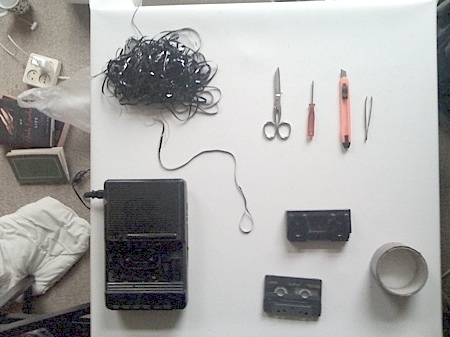 |
To re-spool the disentangled lumps, knots and wads of cassette tape that here and there one may collect, one needs ... cassettes. I use for this the old cassette tapes of which I am given many boxes full by friends and acquaintances. Most often these came from their own collections of tapes, that they decided to get rid of. Or they found them in the street, where they were put outside with other household rubbish for the garbage collectors to pick them up. They then thought of me, and took them home. To bring them over to me later as a present, a surprise. (And always it is :-) ...) These vast quantities of tapes - with an occasional exception - never become part of the Found Tapes Exhibition, because I consider them to be in a different category of findings, more akin to the tapes that I buy at thrift stores or from flea market merchants. Given the time to sift through them, I put aside the ones that contain original or otherwise interesting sound material (home recordings, telephone answering machine tapes, language courses, nicely decorated mix tapes, et cetera). The bulk, which are run-of-the-mill music tapes, I recycle. Either by using them in my dictaphones for recording, or - the case we are looking at here - for re-spooling the broken tapes that are part of the FTE.
In order to use an old cassette for re-spooling cassette tape, one needs to remove the original tape; all of it or just a part of it, depending on the quantity of tape to be re-spooled. Make sure the tape is wound back to its beginning, and then simply pull it out, from the middle of the cassette's front. You may for example use a pair of tweezers, with flattened tips, to get hold of the tape. Now cut the tape, with a pair of scissors or a cutter, just before the spot where the magnetic tape is spliced together with the cassette's leader tape. We can now just continue to pull out by hand the amount of tape that we are going to replace by the strands of found tape that we want to listen to. (Of course you do not throw away the lengths of tape that you recover in this way. I keep them in a huge box, and use them for all sorts of things. Like draping them over other people's heads in a Leipzig mix tape gallery :-) ...)
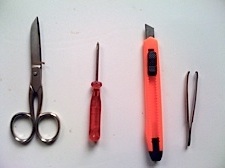 |
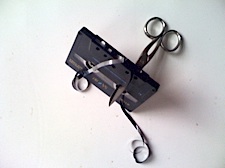 |
We can now splice the ends of a strand of disentangled found tape together with the two loose ends of tape in our re-spooling cassette. For this one can of course use the 'official' sticky white cassette splicing tape. I ran out of it many years ago, but then found that ordinary thin brown plastic cardboard box sticky tape is just as good. The only disadvantage is that it has to be cut to the right size, but that's not so difficult, again using the indispensable pair of scissors or a cutter. (Mind you that for repairing tapes of some value, intended to be durable and/or result in a cassette that can be played back again regularly, one indeed should better use the official splicing tape. Chances are that the cardboard sticky tape will damage the tape, and over time spill out, possibly causing damage to the heads of your player.)
For performing the splicing itself, I use the black plastic splicing block in the picture below. It came with one of these handy hobbyist's 'tape splicing sets' that used to be made available for those wanting and needing to repair themselves their broken audio- and videotapes. Besides enabling one to make a nice 'diagonal' cut, its main use is keeping the two ends of tape in place, and have both hands free to put the sticky tape over the cut.
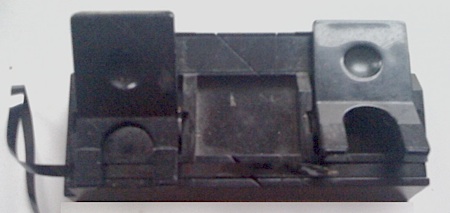 |
Though I presume that the 'hobby splicing kits' no longer are being produced, it still is possible to buy professional aluminum cassette tape splicing blocks. It will be hard to do any sort of precision tape editing without a splicing block (and a fine one-sided sharp razorblade for cutting). But as your goal is nothing but making trashed bits and pieces of tape audible again, it will be possible to do without. Just push the two ends of tape together on a smooth surface (plastic, glass, metal ...), put a bit of sticky tape on one of the ends, and then stick it, as precise as you can, onto the other end. It may take some juggling and patience though, especially because quite a few of the old tapes are very thin, and are difficult to 'keep down', as they're continuously curling away.
You might still find the 'hobby splicing sets' at eBay or comparable web sites, or at thrift stores. Not so long ago I picked a complete and as good as new amateur splicing set for reel-to-reel tape (a BASF Hobby Box) from a pile of garbage in the street, in Amsterdam. Here is a series of pictures from the 'instructions for use' that came with it, which show you how to splice tape:
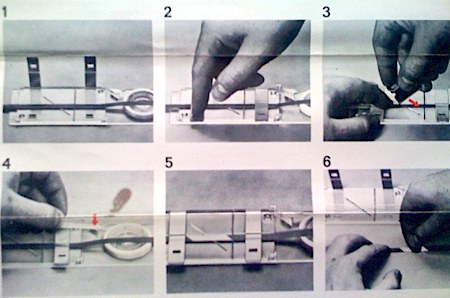 |
What is important, is taking care that you splice the tape the right way up. Only one side of the tape holds the magnetic emulsion used for recording, the other (non-oxide) side is just plastic. It is the emulsion side that during playback will pass along the tape playback head of the cassette player. And it is good practice to attach the sticky tape to the non-oxide side, to the plastic. It is not always evident to see which side of a tape is the emulsion side. I have learned over the years, and in most cases I do 'see' which is the right side. But not always. If I were to judge by eye only, sometimes I would splice a tape the wrong way around. (In that case upon playback the sound will be muffled and playing backwards.) That is why I use the old portable Philips cassette player in the picture, of which I have removed the lid, so I can play back strands of tape, that I put in by hand, to verify that I was right about which side is the emulsion side.
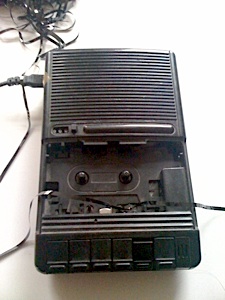 |
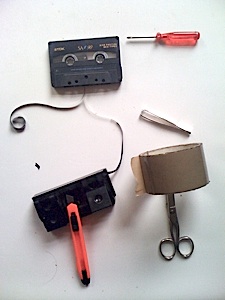 |
When I have spliced the first strand of found tape together with the leader tape of my re-spooling cassette, I wind it into the cassette. By hand. Personally, I use the pair of scissors to do that. But a pencil or something similar will do as well. Do it carefully. Keep the tape between thumb and forefinger, keep it stretched, and take care that it not accidentally will twist during re-spooling. Especially with worn and thin tape, that before its disentangling had been twisted and folded up a lot, this is bound to happen when you do not pay attention. (Also watch out for spots where the tape strand is damaged and likely to break. Re-enforce such spots by putting a small bit of sticky tape on the plastic side.)
I then continue to splice the second strand onto the end of the first one,
and so on, until all of a tape find has been spliced together and re-spooled
into the cassette. We can then 'close' the tape, by splicing the end of
the second bit of tape left in the re-spooling cassette, to the end of the
final strand of found tape.
Usually, I splice all tape finds that come with one acquisition
(those are together on one page of the
FTE web site) into
one re-spooling cassette (or more, if one is too little to take it all),
taking care to separate the successive finds by bits of old leader-tape,
or (lacking that) by bits of blank tape.
Next, I transfer the sounds from the re-spooled found tapes to my computer: I play back the tape on a cassette-deck, and record its playback in simple one track audio editing software, for archiving and further editing into a 'fotex montage' (like, for example, fotex 87 - Found in Brooklyn, NY). After the sounds have been archived, the re-spooled tapes have no longer anything but an object function. But of course I do keep them.
One final important tip: for the re-spooling always use a cassette of which the case can easily be opened and closed again. For some brands the cases of the cassettes are glued shut. The only way to open these is to crack the case. Do not use these for re-spooling. Use the ones that are closed with five little screws: one in each corner, and one in the middle below. (That is why you see the little screwdriver in the picture of my tools. Most of the times, but not always, these are crosshead screws.) Because the found strands of tapes are of varying textures, and in varying degree of disintegration, even though you did your utmost to splice as good and as precise as you can, it is unavoidable that occasionally during playback (or even during the winding of the tape into the re-spooling cassette) a re-spooled tape will snap.
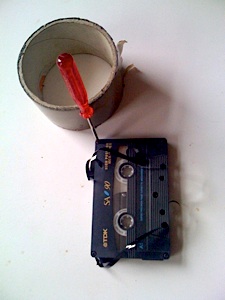 |
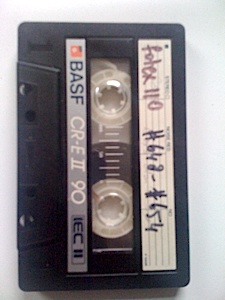 |
If the tape breaks, you will need to open up the case, and slice the ends of the tape back together again. Now this can be a real pain, and also here the pair of tweezers with flat tips will come in handy. It hardly ever is really easy. But one can do it. Beware to first get the ends out, then close the case again, and then finally splice the ends back together again.
Now pray that during next play back the tape will hold ...
...
notes __ ::
(*) A couple of years ago a similar page was part of
Zoe Irvine's magnetic migration
music web site, but when later I looked for it again, I couldn't find
it any more. [ ^ ]
Read all about Found Tapes, Foundtaping and Audio Cassettes (K7s) on the SoundBlog:
(2023, september 21) - Holland[s] Spoor
(2022, january 11) - 'The Art of K7', vol. 1
(2021, september 11) - The Art of K7 :: Sudokaising [ii] Time Folds
(2020, march 21) - The Art of K7 :: Sudokaising [i]
(2019, november 17) - Foundtapers & Foundtaping in Porto
(2019, februay 08) - CCNL :: Cassette Culture in Linz, Austria
[ii] The aesthetics of erasure
(2019, januay 18) - CCNL :: Cassette Culture in Linz, Austria
[i] Oral history
(2015, november 22) - Situasonnisme: the City Sonic Festival
(2014, june 19) - Lecture de Cassette
(2013, october 25) - The Art of K7 (prelude) [sketch/book, 1]
(2013, march 23) - "Ma première cassette était vierge..." Mourning & celebrating 50 years of compact cassette
(2012, july 26) - UnOfficial Release
(2010, november 28) - Foundtaping, Maps & Shadows
at the Basel Shift Festival (i.)
(2009, november 15) - prof. dr. Cassette
(2009, november 08) - A found tapes meta-map
(2009, october 22) - Founded Tapapes
(2009, september 20) - Found Lost Sound
(2009, july 26) - "You, a bed, the sea ..." [ 1. Athens, sept. 28th 1994 ]
(2009, may 23) - It feels like summer in the city [KT2009, i]
(2009, february 19) - Time and the weather - "? Footage or Fetish" @ Käämer 12, Brussels (ii)
(2009, january 30) - A Tingel Tangle Tape Machine - "? Footage or Fetish" @ Käämer 12, Brussels (i)
(2009, january 15) - Kassettenkopf
(2008, december 08) - un-Tuned City (foundtaping in Neukölln)
(2008, september 14) - Psycho/Geo/Conflux in Brooklyn, NY __i.
(2008, august 31) - " Le chasseur " (foundtaping in brussels_ii)
(2008, june 18) - "Sing Laping, Sing !" (foundtaping in brussels_ i)
(2008, january 06) - Mo' Better Mo-Tapemosphere, 2. Restmuell
(2007, june 16) - Mo' Better Mo-Tapemosphere, 1. "chase away all my fear"
(2007, march 07) - Back to Berlin 2. Found Tapes
(2006, september 28) - jenny likes poets
(2006, september 06) - the sound of almost-no-more words
(2006, june 13) - fotex #49-51
(2006, june 04) - Sonofakunsttoer
(2006, april 17-25) - 'sudoku-solution' in 'de nor'
(2006, january 19) - ride, buggy, ride ... !
(2006, january 13) - axiologie for dummies
(2005, november 06) - found in maastricht
(2005, august 28) - tête-de-tettine / tête-de-cassette
(2005, august 23) - tape busters and coordinates
(2005, july 02) - Conquering America ...
(2005, june 03) - stationed soother
(2005, april 21) - Low-fi : the new Readymades
(2005, march 24) - d_Revolution #1 ...
(2005, february 07) - found tapes for spies
(2005, january 28) - "parfois l'amour tourne à l'obsession ..."
(2004, november 06) - à la tranquilité
(2004, july 20) - instructions in arabic
(2004, may 08) - phound stufphs
(2003, august 04) - new acquisitions #7, #8
(2003, may 04) - r2r
(2003, april 24) - splice and tape
(2003, april 15) - new acquisitions #5,#6
(2003, january 09) - finders keepers
(2002, november 24) - exhibit #4
(2002, november 08) - what fascinates me
(2002, november 07) - more on found tape montage
(2002, september 14) - detour
(2002, september 09) - 2 down, 3 to go
(2002, september 06) - magnetic migration
Read about Found Tapes in Gonzo (Circus) [Dutch]:
Gonzo #163, mei/juni 2021 - Lang Leve Lou Ottens
Gonzo #137, januari/februari 2017 - Het Kaf en het Koren
tags: found tapes, tape editing
# .337.
comments for prof. dr. Cassette ::
|
Comments are disabled |